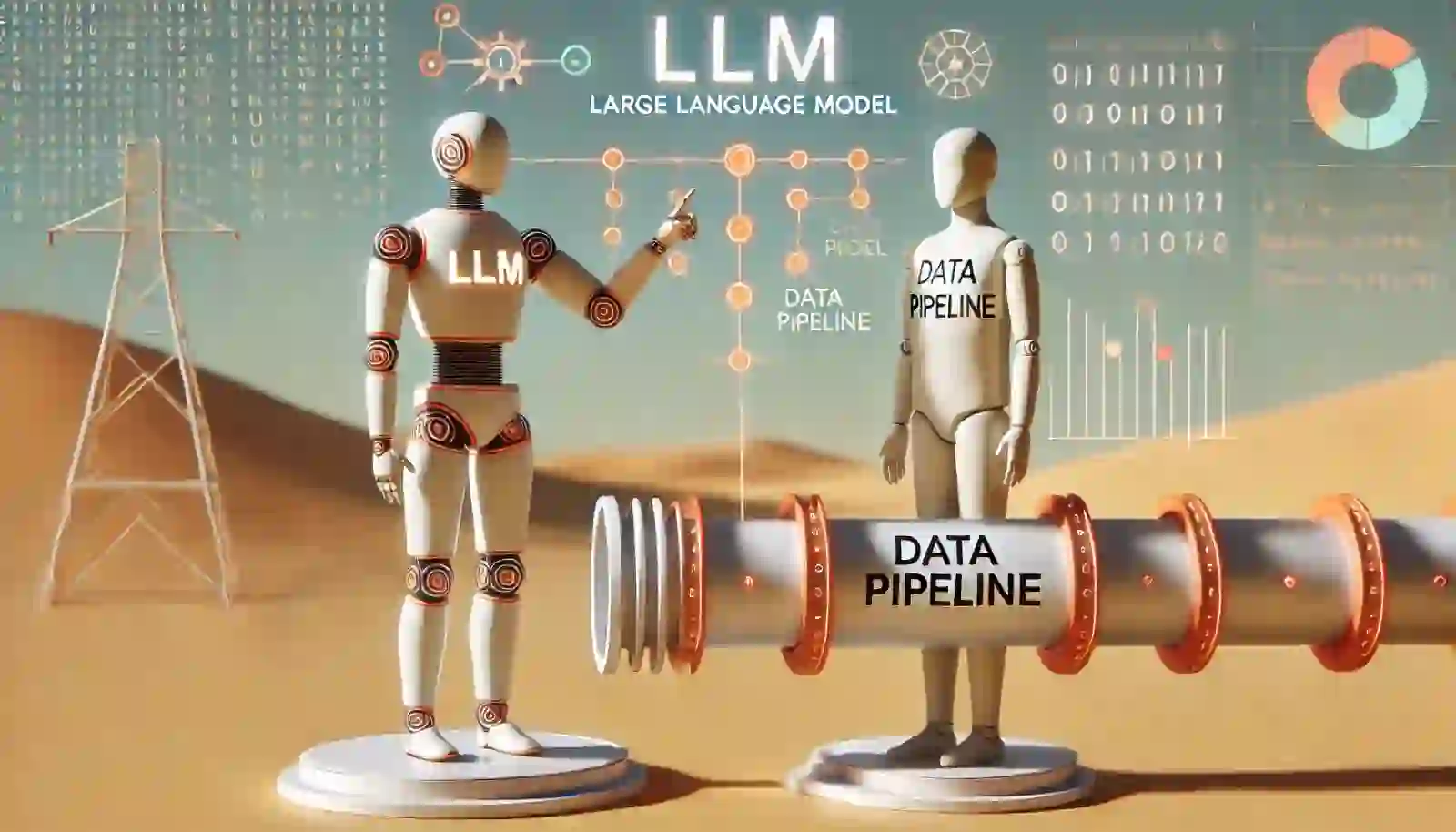Plug-and-Play LLMs for GenAI-Driven Data Pipelines
Explore the transformative potential of Plug-and-Play LLMs for GenAI-driven data pipelines. These advanced systems offer unprecedented efficiency, enhance data quality, and streamline operations to make data management faster and more reliable for businesses to thrive in a digital-first world.

Imagine spending days, even weeks, wrestling with data preparation for a project, only to have a fraction of that time left for actual analysis. This inefficiency plagues many AI projects today, where data wrangling often overshadows the true purpose: extracting valuable insights. However, the tide is turning with the advent of GenAI (Generative AI) approaches and the integration of Large Language Models (LLMs) like GPT-4. These advancements are transforming data pipelines, making them more efficient and powerful.
Data Pipelines: The Powerhouse of Data Management
Data pipelines are the essential engines driving data management and analytics. They act as a series of automated stages that move data from various sources (databases, APIs, social media feeds, log files, etc.), transform it for specific use cases, and ultimately deliver it to a designated location for analysis or operational use. In essence, they are the workhorses that ensure data flows smoothly and efficiently across your systems.
Here's a breakdown of the typical operations within a comprehensive data pipeline:
- Ingestion: Data is retrieved from various sources.
- Validation and Cleaning: Raw data often has errors or inconsistencies. This step checks for missing values, corrects formatting issues, and removes duplicates to ensure data quality.
- Transformation: The data is manipulated to fit the needs of your analysis or application. This may involve filtering, aggregation, deriving new features, or even enriching data with additional context from external sources.
- Orchestration: This ensures all the steps in the pipeline run smoothly and in the right order.
- Storage: The transformed data is delivered to its final destination, which could be a data warehouse for in-depth analysis, a data lake for broader storage, or another system for specific use cases.
- Monitoring and Logging: Data pipelines need to be monitored for errors or slowdowns. Logging tracks what's happening in the pipeline for troubleshooting and maintenance.
- Security: Data security is crucial. This involves protecting data throughout the pipeline from unauthorized access or breaches.
- Version Control: Keeping track of changes made to the pipeline is important. Version control allows you to revert to a previous version if needed.
Examples of Traditional Data Pipeline solutions
AWS Glue, Azure Data Factory (ADF), and Google Cloud Dataflow are top-notch ETL solutions.
Informatica PowerCenter, IBM DataStage, Microsoft SSIS (SQL Server Integration Services), Talend Open Studio, and Pentaho Data Integration (PDI) are also examples of ETL solutions.
Limitations of Data Pipelines
Data pipelines are the workhorses of data management, but traditional approaches can struggle to keep pace with the ever-growing demands of modern data landscapes. Here's a breakdown of the key challenges:
1. Complexity in Management and Scaling: As data volumes and variety explode (structured, unstructured, semi-structured), managing data pipelines becomes increasingly intricate. Traditional methods focused on structured data and ETL (Extract, Transform, Load) may not efficiently handle real-time data streams, complex transformations, or diverse data sources. Scaling these pipelines to accommodate new data sources, formats, and ever-growing data volumes often requires significant manual effort, potentially compromising accuracy, performance, and overall agility.
2. Time-Consuming Processes: Many traditional data pipelines can be slow and cumbersome, particularly when dealing with large datasets or complex transformations. The time it takes to extract, transform, and load data can delay insights, which is particularly problematic in environments where real-time data analysis is crucial.
3. Dependency and Failure Risks: Data pipelines are inherently dependent on the smooth operation of each component. A failure in any stage, such as data ingestion errors, data validation issues, transformation errors, orchestration failures, or storage problems, can cause delays or data losses. These disruptions can have a cascading effect, impacting the entire data flow and leading to business disruptions. Troubleshooting and recovery efforts can be time-consuming and resource-intensive.
4. Data Quality Issues: Data pipelines can introduce or perpetuate data quality issues if not carefully managed. Problems such as data duplication, missing values, or incorrect data can propagate through the pipeline, resulting in unreliable output that affects decision-making processes.
5. Security and Compliance Challenges: Securing data pipelines and ensuring compliance with data protection regulations can be difficult, especially when data is sourced from or sent to multiple systems, some of which may have inadequate security measures. Additionally, ensuring that data handling practices comply with laws like GDPR or HIPAA requires continuous vigilance and can complicate pipeline management.
6. High Maintenance and Operational Costs: Maintaining a data pipeline often involves ongoing infrastructure, software, and personnel costs. As data volumes and processing needs increase, these costs can escalate, impacting the overall return on investment.
7. Skill and Resource Intensity: Designing, implementing, and maintaining effective data pipelines typically requires skilled personnel with expertise in data engineering, data science, software development, and potentially cloud technologies. Finding and retaining talent with the specialized skillset required to manage complex data pipelines can be a challenge, leading to increased costs and potential delays.
Large Language Models (LLMs) and their Data transformation abilities
Large language models (LLMs) are artificial intelligence (AI) that excel at processing and understanding human language. Trained on massive datasets of text and code, they perform various tasks like:
- Text generation: Creating different creative text formats, like poems, code, scripts, musical pieces, emails, letters, etc.
- Machine translation: Converting text from one language to another.
- Question answering: Answer your questions in an informative way, even if they're open-ended, challenging, or strange.
- Text summarization: Condensing lengthy pieces of text into shorter summaries.
However, LLMs are making significant waves in data transformation. Here's how they can be instrumental:
- Data cleaning and normalization: LLMs can identify and fix inconsistencies in data formats, missing values, or typos. They can also help standardize data formats across different sources.
- Data enrichment: LLMs can analyze text data related to your target data and use it to enrich existing records. For instance, an LLM could analyze online reviews to add sentiment scores or categorize customer types if you have customer data.
- Entity recognition and classification: LLMs can pinpoint and categorize important entities within text data. This could involve recognizing names, locations, organizations, or specific products mentioned in customer reviews, social media posts, or surveys.
- Data annotation: Manually annotating data for machine learning can be time-consuming. LLMs can automate some of this process by analyzing text data and suggesting relevant labels or categories.
- Anomaly detection: LLMs can be trained to identify unusual patterns or outliers within your data. This can be helpful for fraud detection or finding inconsistencies in sensor data.
- Feature engineering: LLMs can assist with feature engineering, a crucial step in machine learning where new features are created from existing data. An LLM can analyze the data and suggest potential features based on domain knowledge or identify relationships between existing features that might be useful for building machine learning models.
- Automatic code generation for data pipelines: LLMs can understand the logic behind data transformation steps and translate natural language instructions into code for building data pipelines. This can significantly reduce the time and expertise needed to develop and maintain these pipelines.
- Interactive data exploration: Imagine using natural language queries to directly explore and analyze your data. LLMs can facilitate this by understanding your questions and generating relevant data visualizations or summaries. This empowers users to gain insights from data without writing complex code.
- Data bias detection and mitigation: LLMs can be trained to identify potential biases in text data used for training other AI models. This can help mitigate bias in algorithms and ensure fairer outcomes.
- Data storytelling: LLMs can take insights from data and craft compelling data stories in human-readable language. This can be extremely valuable for communicating complex findings to non-technical audiences.
- Explainable AI (XAI): LLMs can explain the decision-making process of complex AI models, making them more transparent and trustworthy. This is crucial for building trust in AI systems across various domains.
Plug-n-Play LLM for Data Transformation
A plug-and-play LLM (Large Language Model) is a hypothetical concept for an LLM designed to be easily integrated into existing data pipelines without extensive configuration or expertise. While LLMs hold immense potential for data pipelines, making them truly "plug-and-play" is an ongoing area of research and development. Here's a look at some current challenges and promising approaches:
Challenges
- Data Specificity: LLMs are trained on massive amounts of generic data. To be truly plug-and-play for specific data pipelines, they might need fine-tuning on domain-specific datasets relevant to the pipeline's purpose.
- Interpretability and Control: LLMs can be like black boxes, making it difficult to understand how they arrive at their outputs in data transformations. A level of control and interpretability over the LLM's decision-making process might be necessary for critical pipelines.
- Integration Complexity: Integrating LLMs seamlessly into existing data pipelines could require additional development effort. Standardization and user-friendly interfaces would be crucial for wider adoption.
Approaches for Plug-and-Play LLMs
- Pre-trained LLM Modules: Developing a library of pre-trained LLM modules for specific data transformation tasks (e.g., data cleaning, anomaly detection, entity recognition) could be a step towards plug-and-play functionality. These modules could then be integrated into pipelines based on specific needs.
- Natural Language Interfaces: Creating user-friendly interfaces that allow users to specify data transformation tasks in natural language could be a game-changer. This would empower users with less technical expertise to leverage LLMs in their pipelines.
- Explainable LLM Techniques: Research on XAI (Explainable AI) techniques for LLMs is crucial. By understanding how LLMs arrive at their outputs, users can trust their decisions and potentially fine-tune them for better results within pipelines.
- Auto-configuration Tools: Developing tools that automatically configure LLMs based on the data they encounter within a pipeline could streamline the process. This would require advancements in LLM's ability to adapt to new data and tasks.
It's important to remember that LLM technology is still evolving. While true plug-and-play functionality might be some time away, the ongoing research holds immense promise for the future of data pipelines. As LLMs become more specialized, interpretable, and user-friendly, they have the potential to revolutionize how we transform and analyze data.
GenAI-Driven Data Pipelines
Now that we've discussed LLMs and their potential for data pipelines, we're well-equipped to delve into GenAI-Driven Data pipelines.
GenAI, short for Generative AI, refers to artificial intelligence that can create new data, like text, code, or images. A GenAI pipeline specifically focuses on using generative AI techniques to automate and improve the data processing workflows within traditional data pipelines.
GenAI-driven Data Pipelines with Plug-and-Play LLMs
The future of data pipelines is getting a thrilling upgrade with the concept of GenAI-driven pipelines powered by plug-and-play LLMs. These pipelines leverage the automation and intelligence of LLMs specifically designed for seamless integration into existing data processing workflows.
How are they Built?
Creating a GenAI-driven data pipeline with plug-and-play LLMs involves:
1. Data Source Definition: Identify the data sources you want to integrate (databases, APIs, etc.).
2. Data Transformation Tasks: Specify the data transformation steps needed (cleaning, normalization, enrichment, etc.).
3. Plug-and-Play LLM Selection: Choose pre-trained LLM modules for specific tasks based on a library of options (e.g., data cleaning module, anomaly detection module).
4. Integration and Orchestration: Integrate the chosen LLM modules into your pipeline using user-friendly interfaces, and the orchestration engine handles the workflow.
5. Monitoring and Evaluation: Monitor the pipeline's performance, evaluate the effectiveness of LLM modules, and fine-tune as needed.
Components of a GenAI Pipeline with Plug-and-Play LLMs
- Data Sources: The starting point for the data, which can be various databases, applications, sensors, or APIs.
- Data Processing Tools: Traditional ETL (Extract, Transform, Load) tools used for data movement and manipulation.
- Plug-and-Play LLM Modules: Pre-trained LLM components designed for specific data transformation tasks within the pipeline (e.g., cleaning, anomaly detection).
- Orchestration Engine: A tool that manages the workflow and execution of different stages within the pipeline.
- Monitoring and Logging Tools: Systems to track the pipeline's performance, identify errors, and ensure data quality.
Benefits of Plug-and-Play LLMs in GenAI Pipelines
- Turbocharged Efficiency and Development Speed: Imagine building data pipelines with pre-built LLM modules for data cleaning, anomaly detection, or entity recognition. This eliminates the need for complex coding, significantly reducing development time and freeing up data scientists for more strategic tasks.
- Enhanced Data Quality and Machine Learning Performance: LLMs trained on massive datasets can identify and rectify errors and inconsistencies within data, leading to cleaner, more reliable data for analysis. This, in turn, can significantly enhance the performance of machine learning models trained on this improved data.
- Cost Reduction, Scalability, and Flexibility: Plug-and-play LLMs are designed for ease of use and scalability. Businesses can choose the LLM modules they need and integrate them into pipelines without extensive customization, leading to potential cost savings and easier scaling as data volumes fluctuate.
- Democratization of AI: The user-friendly nature of plug-and-play LLMs can make GenAI pipelines more accessible to businesses of all sizes, even those with limited data science expertise. This democratization of AI empowers a wider range of organizations to leverage the power of GenAI for data-driven decision-making.
Challenges and Considerations
- Regulatory Considerations for LLM Deployment: As with any AI technology, potential regulatory hurdles must be considered when deploying LLMs within pipelines. Issues around data privacy, security, and potential bias in LLM outputs need to be addressed to ensure responsible and compliant use.
- Explainability and Interpretability: A crucial challenge in AI is understanding how models make decisions. This is especially true for LLMs, which can be complex and opaque. Ensuring the explainability and interpretability of LLM outputs within pipelines is essential for trust and responsible use.
- Ethical Considerations: Ethical considerations permeate the entire LLM development and deployment lifecycle. From the data used to train LLMs to potential biases in their outputs, organizations need to implement robust ethical frameworks to ensure responsible AI practices.
How the industry can take advantage of GenAI-driven Data Pipeline augmented with Plug-n-Play LLMs
The potential of GenAI-driven data pipelines with plug-and-play LLMs to revolutionize data processing extends across numerous industries. Here's a glimpse into how different sectors could leverage these pre-trained LLM modules for enhanced automation and intelligent data transformation:
1. Finance
Imagine a data pipeline built to analyze financial transactions for fraud detection. In this scenario:
- Data Source: Transaction data from credit cards, bank accounts, and payment gateways would flow into the pipeline.
- Plug-and-Play LLM Module: A pre-trained LLM for anomaly detection would be incorporated. This module, designed specifically for this task, would analyze transaction patterns and identify suspicious activities deviating from a customer's typical spending behavior.
- Action: The pipeline would then trigger alerts for flagged transactions, allowing investigators to take necessary actions.
2. Healthcare
A GenAI pipeline could be designed to analyze medical images for faster and more accurate diagnoses. Here's how it might work:
- Data Source: Medical images (X-rays, MRIs) from various imaging machines would be fed into the pipeline.
- Plug-and-Play LLM Module: An LLM pre-trained for medical image analysis would be integrated. This module would be trained on vast datasets of medical images labeled with specific pathologies.
- Output: The LLM module would analyze and classify the incoming image, highlighting potential abnormalities or matching it with known disease patterns. This would assist radiologists in their diagnoses and potentially reduce misdiagnosis rates.
3. Manufacturing
Predictive maintenance is crucial for preventing costly downtime in manufacturing. Here's how a GenAI pipeline with LLMs could be applied:
- Data Source: Sensor data from machines on the production line, including temperature, vibration, and power consumption, would be collected.
- Plug-and-Play LLM Module: An LLM pre-trained for predictive maintenance would be incorporated. This module would analyze sensor data streams and identify patterns that might indicate an impending equipment failure.
- Action: The pipeline would trigger alerts for potential issues, allowing technicians to perform preventive maintenance before a machine breaks down.
4. Retail
Personalizing the customer experience is key to boosting sales in retail. Here's how LLMs could be integrated into a GenAI pipeline for this purpose:
- Data Source: Customer purchase history, browsing behavior, and demographic information would be fed into the pipeline.
- Plug-and-Play LLM Modules: Two potential LLM modules could be used here:
- LLM for Recommendation Generation: This module, trained on customer data and product information, would recommend products likely to interest a specific customer based on their past purchases and browsing behavior.
- LLM for Sentiment Analysis: This module would analyze customer reviews and social media conversations to understand customer sentiment towards specific products.
- Action: The pipeline would leverage the recommendations and sentiment analysis to personalize product recommendations displayed to each customer, leading to a more engaging shopping experience.
These are just a few examples, and the possibilities are vast. Plug-and-play LLMs can be designed for various data transformation tasks, allowing businesses to build customized GenAI pipelines that cater to their specific needs.
Here are some additional benefits to consider:
- Reduced Development Time: Pre-trained LLMs can significantly reduce the time and expertise required to develop and deploy data pipelines.
- Improved Scalability: Plug-and-play LLMs can be easily scaled up or down to handle fluctuating data volumes.
- Increased Accessibility: These LLMs' user-friendly nature can make GenAI pipelines more accessible to businesses of all sizes, even those with limited data science expertise.
Companies Exploring GenAI Pipelines with Potential for Plug-and-Play LLMs:
1. Rivery
- Focus: Automation and Abstraction. Rivery simplifies data pipeline creation and management. It offers pre-built connectors, data transformation tools, and automation features to reduce manual coding and streamline the process.
- Strengths:
- User-friendly interface: Ideal for businesses with limited data science expertise.
- Focus on automation: Frees up data engineers for more strategic tasks.
- Starter kits and templates: Provide a good starting point for common data pipeline tasks.
- Potential LLM Integration: Rivery positions itself well for future integration with plug-and-play LLMs (Large Language Models), offering pre-trained modules for specific data transformation tasks within pipelines. This could further enhance automation and accessibility.
- Limitations: While Rivery offers a robust platform, it might not be suitable for highly customized or complex data pipelines requiring extensive coding.
2. Vertex AI (Google Cloud)
- Focus: Machine Learning Integration. Vertex AI is a comprehensive platform from Google Cloud offering tools for building, deploying, and managing machine learning models at scale. Data pipeline functionalities are embedded within this broader set of machine learning capabilities.
- Strengths:
- Tight integration with Google Cloud services: Seamless data flow between various Google Cloud products.
- Feature-rich machine learning environment: Supports various machine learning tasks beyond data pipelines.
- AutoML capabilities: Automates machine learning model selection and training for specific tasks.
- Limitations: Vertex AI's data pipeline functionalities might be less intuitive for users unfamiliar with the Google Cloud ecosystem. The platform might have a steeper learning curve compared to Rivery.
3. SageMaker (Amazon Web Services)
- Focus: Flexibility and Scalability. SageMaker, offered by AWS, is a cloud-based machine learning platform known for its flexibility and ability to handle large-scale data processing tasks. It provides tools for building, training, and deploying machine learning models, including functionalities for data pipelines.
- Strengths:
- Extensive library support: Supports various machine learning frameworks and algorithms.
- Cost-effectiveness: Offers various pricing options to fit different needs.
- Large user community: Easier to find support and resources compared to some competitors.
- Limitations: SageMaker can be complex to set up and manage, requiring more technical expertise from users than Rivery. Additionally, while SageMaker supports data pipelines, its focus might be more on the machine learning aspects compared to Rivery's pipeline-centric approach.
Choosing the Right Platform
The best platform for your needs depends on your specific requirements, technical expertise, and budget. Here's a quick guideline:
- For ease of use and automation: Rivery is a strong contender, especially for businesses with limited data science expertise.
- For tight integration with Google Cloud services and a robust machine learning environment: Vertex AI is a good choice.
- For flexibility, scalability, and a large user community: SageMaker could be the better option, especially if you have the technical expertise to manage it.
The Future is Bright
While widespread adoption of plug-and-play LLM technology is still on the horizon, the potential is undeniable. Imagine building data pipelines with the ease of using building blocks! As research progresses and technology matures, GenAI-driven data pipelines powered by plug-and-play LLMs promise to revolutionize how we process and transform data.


